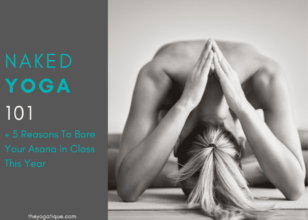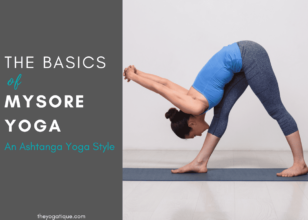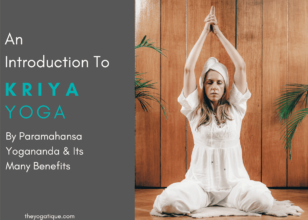Inversions and arm balances are among my favorite yoga poses. Hence why Rocket Yoga, with its emphasis on inversions, is one of my favorite styles of yoga to practice. In this article, I explain what Rocket Yoga is, where it comes from, and how it can level up your practice.
If you also love the challenge of inversions and arm balances and the creative and dynamic flow of Vinyasa yoga, then the lesser-known Rocket Yoga will surely be your cup of tea. Never heard of it? Then read on to learn what Rocket Yoga is and why you should try it.
Article content:
(Click any link below to jump directly to section)
What is Rocket Yoga
Rocket Yoga is a strong and dynamic yoga style based on the traditional Ashtanga system.
The philosophy around this style of yoga is that these sequences will “get you there faster” in terms of physical and mental transformation.
As an avid Vinyasa yoga fan, I enjoy Rocket Yoga as there are many similarities between the two styles. Like Vinyasa, Rocket Yoga features creative and flowing sequences. The classes are often very playful and fun, incorporating many inversions and arm balances.
I find the best way to describe Rocket Yoga is as a modern interpretation of traditional Ashtanga Yoga. This style of yoga promotes freedom over structure. It allows you to explore different poses and sequences you wouldn't encounter in the structured Ashtanga style.
The founder of Rocket Yoga, Larry Schultz
American yoga teacher Larry Schultz, a former student of Pattabhi Jois, developed the Rocket Yoga style. Schultz began practicing yoga at an early age, initially studying under Sri Swami Satchidananda. However, in the 1980s, he traveled to India and began studying and practicing with Ashtanga Yoga founder Pattabhi Jois.
Schultz became one of Jois's most dedicated students, earning his authorization to teach the Ashtanga method. However, upon returning to the United States, Schultz created his own yoga method – Rocket Yoga.
7 benefits of Rocket Yoga
As a physically demanding practice, Rocket Yoga offers many physical benefits. It is ideal for anyone who prefers a vigorous practice that pushes their body to the limits. The benefits of Rocket yoga include:
- Boosts cardiovascular health – Because Rocket yoga is a fast-paced and dynamic practice, it is an intense cardio workout. The fast flows and inversions elevate your heart rate and increase circulation, improving heart health.
- Improves flexibility – Combining breath awareness and mindful movement helps improve flexibility and mobility in the muscles and joints.
- Builds strength – Rocket Yoga sequences feature challenging poses that target various muscle groups. It also focuses on inversions and arm balances, postures that help build strength and endurance in the core and upper body.
- Enhances energy levels and vitality—Rocket Yoga sequences are designed to invigorate the body and stimulate prana (energy flow). Thus, many practitioners practice Rocket Yoga in the morning to energize and prepare for the day.
- Regulates stress reduction and emotional balance – Rocket yoga emphasizes connection to the breath and the present moment. This helps to promote a sense of calmness and relaxation, leaving you feeling more centered and grounded.
- Increases focus and mental clarity – As you concentrate on your breath, movement, and alignment, your mind becomes clearer. This mental clarity carries over into your daily life, helping you stay focused on tasks for longer.
- Promotes self-awareness and mindfulness – As you become more aware of your body and breath, you foster a deeper connection with yourself, promoting personal growth and self-discovery.

Rocket Yoga vs Ashtanga Yoga
Rocket Yoga is a modernized, modified, and more accessible version of Ashtanga Yoga. While Rocket Yoga sequences are structured and based on the Ashtanga system, they allow for more flexibility and creativity.
Rocket Yoga sequences incorporate more modifications and variations than Ashtanga. It also includes additional poses, providing a more dynamic and varied practice.
Another key difference between Rocket and Ashtanga yoga is the pace. Rocket Yoga has a faster pace and the asanas are sequenced together in a flow, creating a more energetic and invigorating practice.
I personally feel that Ashtanga yoga is sometimes too strict. If you agree, you will likely prefer Rocket Yoga, which has a more playful and lighthearted atmosphere.
Sure, the discipline and focus in Ashtanga yoga have their purpose. But I find Rocket Yoga adds an element of fun and spontaneity to the dynamic sequences I know and love.
Is Rocket Yoga good for beginners?
Despite focusing on advanced postures, Rocket Yoga encourages you to feel empowered making it great for all levels. Rocket Yoga teachers offer various modifications , making the style accessible and fun to beginners.
Rocket yoga tips for beginners
Rocket Yoga incorporates many asanas from the Ashtanga method. So learning this style is easier if you already have basic knowledge of Ashtanga yoga. However, if you don't, don't fret! Here are a few elements of Rocket Yoga you can familiarise yourself with before your first class:
- Breath awareness – Rocket yoga is fast and vigorous, so you'll need to develop a good connection with your breath to maintain your stamina. Get into the habit of doing so now by taking a few minutes to breathe deeply, focusing on the inhalation and the exhalation.
- Sun salutations – The rocket yoga sequence starts with Surya Namaskar A and B, also known as sun salutations. These standing sequences build heat to prepare the body for the following asanas.
Remember that Rocket Yoga is an intense and challenging practice. Thus, listening to your body and respecting its limitations is essential, especially when you are starting out. Here's how to have a great Rocket Yoga class experience:
- Observe your body's signals. If you feel sharp or shooting pain, ease out of the pose.
- Don't push yourself too hard; Take breaks, modify poses, or skip them whenever needed.
- Don't compare yourself to other practitioners or try to keep up with them. Everyone progresses through their practice at their own pace, so stay focused on yourself only.
Takeaway on Rocket Yoga
Rocket yoga is a fabulous yoga practice for anyone who loves the dynamic nature of Vinyasa yoga or the challenge of Ashtanga.
Regular Rocket yoga can help you progress faster in your asana practice, mastering some of the most challenging yoga postures. So, if handstands and arm balances excite and energize you, you'll love Rocket Yoga!
Some online yoga studios, online yoga teacher training programs, and brands that we write about may offer us a small percentage should you decide to purchase after reading our content. Thank you for enabling us to exist!









